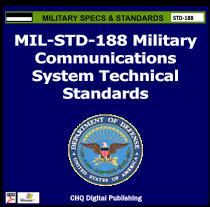
MIL-STD-188 is a series of U.S. military standards relating to telecommunications.
In NATO, a Standardization Agreement defines processes, procedures, terms, and conditions for common military or technical procedures or equipment between the member countries of the alliance. Each NATO state ratifies a STANAG and implements it within their own military. The purpose is to provide common operational and administrative procedures and logistics, so one member nation's military may use the stores and support of another member's military. STANAGs also form the basis for technical interoperability between a wide variety of communication and information systems (CIS) essential for NATO and Allied operations. The Allied Data Publication 34 (ADatP-34) NATO Interoperability Standards and Profiles which is covered by STANAG 5524, maintains a catalogue of relevant information and communication technology standards.
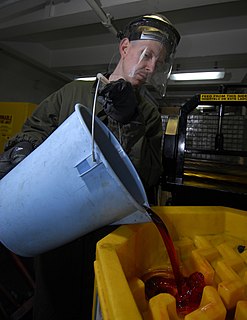
A hydraulic fluid or hydraulic liquid is the medium by which power is transferred in hydraulic machinery. Common hydraulic fluids are based on mineral oil or water. Examples of equipment that might use hydraulic fluids are excavators and backhoes, hydraulic brakes, power steering systems, transmissions, garbage trucks, aircraft flight control systems, lifts, and industrial machinery.

Secure Terminal Equipment (STE) is the U.S. government's current, encrypted telephone communications system for wired or "landline" communications. STE is designed to use ISDN telephone lines which offer higher speeds of up to 128 kbit/s and are all digital. The greater bandwidth allows higher quality voice and can also be utilized for data and fax transmission through a built-in RS-232 port. STE is intended to replace the older STU-III office system and the KY-68 tactical system. STE sets are backwards compatible with STU-III phones, but not with KY-68 sets.

A tactical light is a flashlight used in conjunction with a firearm to aid low-light target identification, allowing the marksman, law enforcement officer or soldier to simultaneously aim a weapon and illuminate the target. Tactical lights can be handheld or mounted to the weapon with the light beam parallel to the bore. Tactical lights also serve a role as a method of non-lethal force, used to temporarily blind and disorient targets or, in the case of a large metal Maglite with D batteries, police can use the flashlight as a billy club. Features particularly associated with tactical lights include shock resistance, reliability, lightweight construction and powerful, long-lasting batteries, and high light intensity. Tactical lights may have optional filters to produce colored light ,e.g red light, to not attract bugs, or may emit only infrared radiation for use with night vision equipment. A sighting laser may also be added to a weapon-mounted tactical light.

Oshkosh Corporation, formerly Oshkosh Truck, is an American industrial company that designs and builds specialty trucks, military vehicles, truck bodies, airport fire apparatus, and access equipment. The corporation also owns Pierce Manufacturing, a fire apparatus manufacturer in Appleton, Wisconsin and JLG Industries, a leading manufacturer of lift equipment, including aerial lifts, boom lifts, scissor lifts, telehandlers and low-level access lifts. Based in Oshkosh, Wisconsin, the company employs approximately 16,000 people around the world. It is organized in four primary business groups: access equipment, defense, fire and emergency, and commercial.

The Martin Mace was a tactical cruise missile developed from the Martin TM-61 Matador later MGM-1 Matador. It was replaced by the MGM-31 Pershing missile by then Secretary of Defence Robert McNamara, and later in its role as a cruise missile for West Germany, by the BGM-109G Ground Launched Cruise Missile.

An airlift is the organized delivery of supplies or personnel primarily via military transport aircraft.

Military transport aircraft or military cargo aircraft are used to airlift troops and military equipment to support military operations. Transport aircraft can be used for both strategic and tactical missions, and are often diverted to civil emergency relief missions.
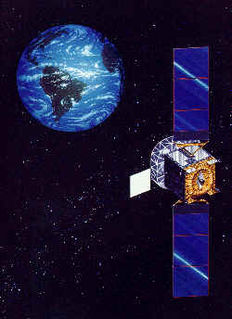
The Ultra High Frequency Follow-On (UFO) system is a United States Department of Defense (DOD) program sponsored and operated by the U.S. Navy to provide communications for airborne, ship, submarine and ground forces. The UFO constellation replaced the U.S. DOD Fleet Satellite Communications System (FLTSATCOM) constellation and will consist of eleven satellites. The ground terminal segment consists of equipment and resident personnel at existing satellite communication stations. The spacecraft are controlled by the Naval Satellite Operations Center (NAVSOC) located at the Naval Base Ventura County, Point Mugu, CA.

The breathing performance of regulators is a measure of the ability of a breathing gas regulator to meet the demands placed on it at varying ambient pressures and temperatures, and under varying breathing loads, for the range of breathing gases it may be expected to deliver. Performance is an important factor in design and selection of breathing regulators for any application, but particularly for underwater diving, as the range of ambient operating pressures and temperatures, and variety of breathing gases is broader in this application. A diving regulator is a device that reduces the high pressure in a diving cylinder or surface supply hose to the same pressure as the diver's surroundings. It is desirable that breathing from a regulator requires low effort even when supplying large amounts of breathing gas as this is commonly the limiting factor for underwater exertion, and can be critical during diving emergencies. It is also preferable that the gas is delivered smoothly without any sudden changes in resistance while inhaling or exhaling, and that the regulator does not lock up and either fail to supply gas or free-flow. Although these factors may be judged subjectively, it is convenient to have standards by which the many different types and manufactures of regulators may be objectively compared.

The United States Air Force's 281st Combat Communications Group was a Rhode Island Air National Guard combat communications unit located in North Smithfield, Rhode Island, United States.
An Airborne Network (AN) is the infrastructure owned by the United States Air Force that provides communication transport services through at least one node that is on a platform capable of flight.

PM WIN-T is a component of Program Executive Office Command, Control and Communications-Tactical in the United States Army. PM WIN-T has been absorbed into PM Tactical Networks as Product Manager for Mission Networks.
This is a list of the acronyms and abbreviations used in avionics.

The Storm Search and Rescue Tactical Vehicle (SRTV) is an all-terrain light military vehicle developed by the United States. It was the winner of the Guardian Angel Air-Deployable Rescue Vehicle (GAARV) competition awarded by the Air Force Life Cycle Management Center (AFLCMC). The competition was named for the pararescuemen and combat rescue officers known as the "Guardian Angel Weapon System." The Storm SRTV is to be used by the United States Air Force Pararescue.
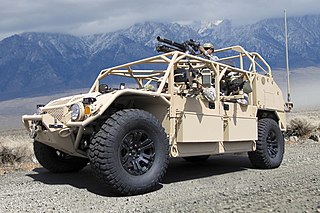
The U.S. Army Ground Mobility Vehicle, previously just GMV, and formerly called the Ultra Light Combat Vehicle (ULCV), is a U.S. Army proposed airdroppable light off-road vehicle to improve the mobility of light infantry brigades. In March 2015, the Army changed the name of the ULCV to the Ground Mobility Vehicle. GMV is intended to be carried internally in a CH-47 Chinook or externally by a UH-60 Black Hawk. In order to be survivable but transportable, the GMV would be lightly armored and use speed, maneuverability, and off-road mobility to avoid major threats.
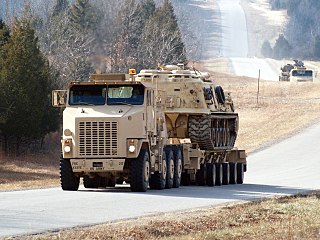
The Oshkosh M1070 is a U.S. Army tank transporter tractor unit. In current service in A0 and A1 configurations, the M1070 is coupled to a DRS Technologies M1000 semi-trailer. The primary purpose of this combination is the transport of the M1 Abrams tank.
![]() This article incorporates public domain material from the General Services Administration document: "Federal Standard 1037C".(in support of MIL-STD-188)
This article incorporates public domain material from the General Services Administration document: "Federal Standard 1037C".(in support of MIL-STD-188)













